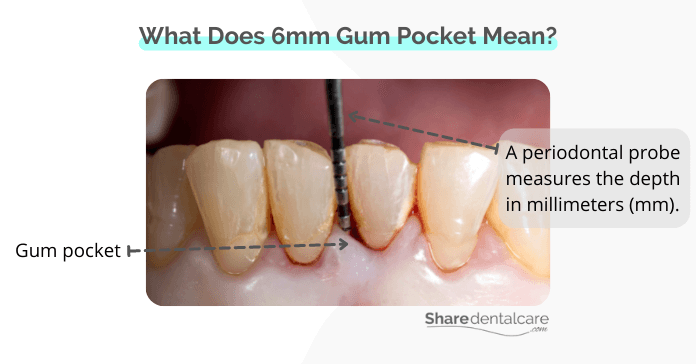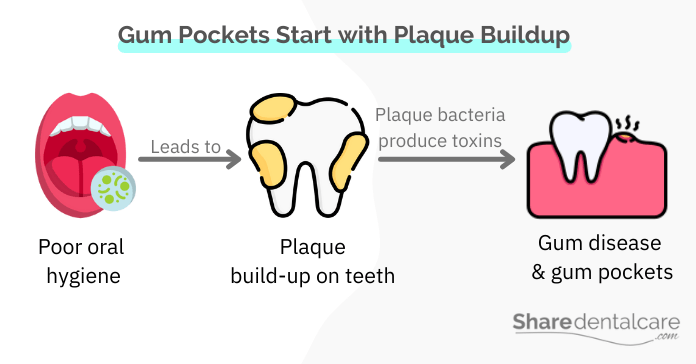1mm to 3mm is the normal depth of gum pockets, which are the spaces between the teeth and gums. When these spaces become too deep, they can be difficult to clean and results in an increased risk for tooth loss and other dental problems. In this blog post, We will discuss what a 6mm gum pocket means, its causes, and its treatment options.
What’re Gum Pockets?
Healthy gums fit snugly around your teeth with very little space between the tooth and gum (gingival sulcus). Gum disease causes this space to deepen, forming what’s known as “gum pockets”. These pockets can become filled with infection-causing bacteria.
Gum pockets are a sign of periodontitis, an advanced stage of gum disease. If left untreated, periodontitis can progress and destroy the bone and connective tissue that support your teeth, eventually leading to tooth loss.
Signs and symptoms associated with gum pockets include:
- Gums that bleed easily
- Swollen, red, or tender gums
- Persistent bad breath
- A pocket of pus in the gums
- Gums that have pulled away from your teeth
- Loose or shifting teeth
What Does 6mm Gum Pocket Mean?
Gum pocket depth is measured in millimeters (mm) with a periodontal probe. The deeper the pocket, the more severe the periodontitis. Gum pockets are classified by their depth.
- 1mm to 3 mm: This means you have healthy gums.
- 4mm to 5mm: This may be an early sign of periodontitis.
- 6mm to 7mm gum pocket: This means you have moderate periodontitis.
- More than 7mm: This means you have severe periodontitis, which can lead to tooth loss if left untreated.

How Does a 6mm Gum Pocket Develop?
Gum disease is the primary cause of 6mm gum pockets. Gum disease is an infection of the gums that occurs due to the buildup of severe plaque on teeth. Dental Plaque is a sticky film of bacteria that constantly forms on your teeth. If not removed, plaque can turn into tartar (heavy calculus on teeth), which is a harder substance that can only be removed by a dental professional.
Plaque bacteria decompose sugars and starches in the mouth, producing acids that cause inflammation of the gums. This is called gingivitis, which is the early stage of gum disease. Gingivitis can be reversed with proper oral hygiene and professional teeth cleaning. However, if gingivitis isn’t treated, it can progress to periodontitis.
Periodontitis is an advanced stage of gum disease that damages the connective tissue and bone that support your teeth. This can cause the gum tissue to separate from the teeth and form pockets (spaces) that become filled with bacteria, plaque, and tartar. These pockets allow bacteria to grow and cause further damage to the teeth and gums.
If you have a 6mm gum pocket, it’s important to see a dentist or periodontist right away. They will develop a treatment plan to clean the pockets and stop the progression of gum disease.
You can read more about painful gums around a wisdom tooth.

Risk Factors
A 6mm gum pocket is considered a moderate case of periodontitis and can lead to tooth loss if left untreated. Several factors can increase your risk of developing an inflamed, swollen gum pocket, including:
- Poor oral hygiene
- Smoking or chewing tobacco
- Hormonal changes during puberty, pregnancy, menopause, or monthly menstrual cycles
- Medications that cause dry mouth as a side effect
- Vitamin C deficiency
- Certain medical conditions such as diabetes, HIV/AIDS, and leukemia
- Certain medications such as steroids, cancer treatments, and oral contraceptives
- Genetics
How is a 6mm Gum Pocket Treated?
The goal of treatment is to clean the pockets and stop the progression of gum disease. Treatment options will vary depending on the severity of your periodontitis.
Mild periodontitis can be treated with good oral hygiene at home and professional teeth cleaning by a dentist or oral hygienist. This will remove the plaque and tartar from your teeth, help reduce inflammation, and promote gum healing.
Moderate to severe periodontitis will require more aggressive treatment, which may include:
- Scaling and root planing: This is a deep cleaning procedure that removes plaque and brown tartar from your teeth and roots. Read more about why some people experience loose teeth after deep cleaning.
- Antibiotics: These can be used to help reduce inflammation and the number of bacteria in your mouth.
- Surgery: In severe cases, surgery may be necessary to clean the pockets and repair damage caused by periodontitis, for example, flap surgery or bone and tissue grafts.
- Tooth extraction: teeth may need to be removed if they are loose or damaged beyond repair.
If you have a 6mm gum pocket, it’s important to see a dentist or periodontist right away. They will develop a treatment plan to clean the pockets and stop the progression of gum disease. Untreated gum disease can lead to tooth loss and other serious health problems.
How to Prevent Gum Pockets?
Gum pockets can be prevented with good oral hygiene. So, follow these tips to keep your gums healthy:
- Brush your teeth twice a day with toothpaste that contains fluoride.
- Floss daily to remove plaque from areas your toothbrush can’t reach.
- Visit your dentist or periodontist regularly for professional teeth cleaning and checkups.
- Eat a healthy diet and avoid sugary snacks.
- Quit smoking or chewing tobacco.
- Manage your medical conditions, such as diabetes.
- Take your medication as prescribed and talk to your dentist about any side effects.
6mm Gum Pocket – Conclusion
Gum pockets are spaces that form between the teeth and gums as a result of periodontitis, an advanced form of gum disease. They are measured in millimeters (mm) with a periodontal probe. The deeper the pocket, the more serious the periodontitis.
A 6mm gum pocket means that you have moderate periodontitis, which can lead to tooth loss if left untreated. Treatment options will vary depending on the severity of your periodontitis, including scaling and root planing, antibiotics, and surgery.